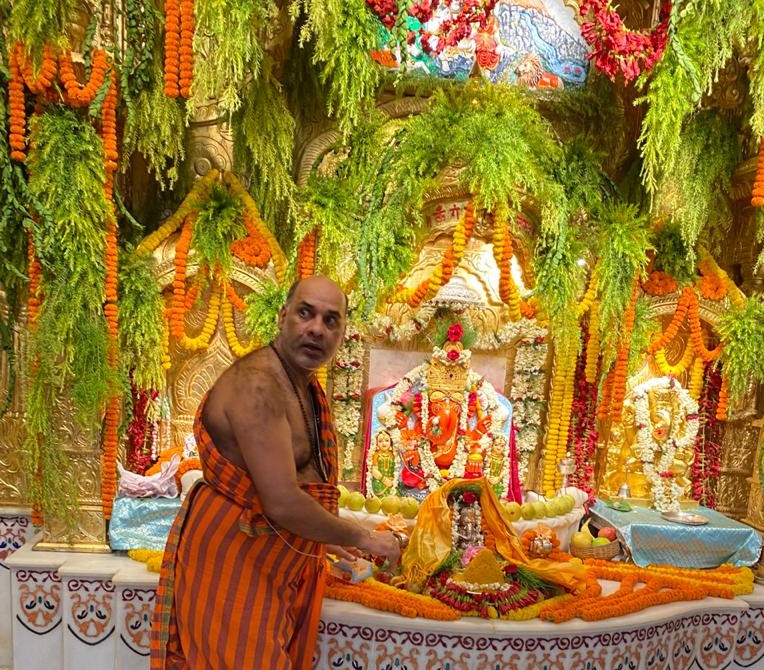One part art, two part religion
Away from the cacophonous traffic of backfiring trucks, yellow coloured taxis and belching lorries, Kolkata’s very own Siddhivinayak temple for Lord Ganesha welcomes visitors.
The temple is housed in a palatial building that stands cheek by jowl to the expansive Marble Palace in the cacophonous Babu Muktaram Street. Interestingly, it is the only street in Kolkata which is home to two iconic buildings of historical importance.
Of all forms of India’s elephant-headed God, the Siddhivinayak form is special because it is carved out of a single piece of stone and has the trunk of the deity on the right instead of left.
The temple in Kolkata is gaining prominence in a city where over 10,000 Ganesh festivals were celebrated this year. Even a decade ago, such festivals were limited to the city’s burgeoning Marwari community. But now, the numbers are growing. Almost every neighbourhood in Kolkata celebrates Ganesh Chaturthi, which marks the birth of the god of wisdom and property.

The iconic temple is still not triggering breaking headlines but, its organisers claim the shrine is gaining popularity because many in the city have shunned jobs and shifted to small and medium-scale business where Lord Ganesh is worshipped routinely. What has also worked to the temple’s advantage is the fact that it is located in north Kolkata, home to the city’s Marwari community.
Such is the fervour that this year, organisers of the Ganesh festivals demanded they also should be given special permission for immersion like Durga, Kali and Jagatdhatri idols.
“The crowds are growing by the day,” says Pradeep Nayyar, a top aide at the temple.
In a city where religious discussions instantly turn into a peculiar Hindu-Muslim divide, this temple stands like a beacon of hope. Not even an iota of the Bharatiya Janata Party’s clarion call for the rise of Hindutva forces have touched the temple. During the Ganesh Chaturthi celebrations last week, a top Trinamool minister, Firhad Hakim — fondly called Bobby by his friends — came for the inauguration of the festivities.

It reflected the temple’s deep, secular identity.
Historians in Kolkata say the Siddhivinayak temple is housed in a historic building. It was a 200 year-old palace owned by the once powerful Mullick family. The cousins owned two huge palatial buildings next to each other on the Muktaram Babu Street that lies close to the Jorasanko ancestral home of Rabindranath Tagore, considered the Shakespeare of Bengal.
The family that owned the Marble Palace was not the same as the one which owned the building where the temple is now housed. The place which has been taken over for the temple was once owned by Panchnan Mullick and Nilmoni Mullick.

The building, which once looked almost like the Marble Palace, was the venue for RS Agarwal and RS Goenka, two young entrepreneurs and childhood friends, for their business venture that would blend ayurveda with modern science. The two had left their high-profile corporate jobs with the Birla Group; they had only Rs 20,000 in their purse. “We operated from one corner of the building. It was in the 70s, and it was a very bold move,” Sushil Goenka said in an interview.
Sushil Goenka is the younger brother of RS Goenka, one of the two friends who shaped their dreams in Kolkata way back in the seventies.

“The small room in that building showed us the morning. My brother and Aggarwalji used to operate from there but eventually shifted out after government regulations prevented companies from running factories from residential homes. And eventually, we acquired the building which was in a very, very dilapidated state. We wanted to construct Kolkata’s first Ganesh temple,” said Goenka.
The building was bought over in 2015 and its architecture revived during its reconstruction, including tall fluted Corinthian pillars. It was a herculean task. And finally, February 28, 2020, the temple, and the Devasthanam — the sanctum sanctorum — the duo offered Emami to Lord Ganesh as a memorandum of gratitude. And the temple was opened for the masses.

As per the Hindu calendar, it was 16 Phagun, the 59th day of Vikram Samvat Hindu, 2076.
Emami was founded in 1974, a momentous year as India – under project Smiling Buddha – detonated a nuclear device and became the sixth nation to do so. It was also a year of great Bollywood hits. Manoj Kumar made Roti Kapda Aur Makan, Amitabh Bachchan blazed the silver screen with his classy Majboor. The Ganesh temple in Kolkata finally opened its doors in 2020. In between, 46 long years had passed.
“We worship the Gods, and also human beings,” said Goenka. At the western end of this sanctorum lies a small Hanuman temple, facing Shri Siddhivinayak, just like the Siddhivinayak temple in Mumbai. In a large part of the sanctorum, various social service projects like health services, employability and skill development centres are being run.
Popularity of the temple, which has a priest from Mumbai’s Siddhivinayak shrine, is on the rise. A top official of the Mumbai temple told this reporter that he was both amazed and happy that Kolkata has its own Siddhivinayak temple. “I am sure this is driven by Lord Ganesha’s immense popularity across India. Many cities now have Siddhivinayak temples,” said Padurang Sandim, a senior official of the Mumbai temple.
Sandim said Ganesh worshipping has become extremely popular across India, it is not a region centric festival.
Historians in Kolkata are already calling the temple a landmark. And the fact that the temple is located next to the Marble Palace adds great value to both the institutions. One, built in 1835 by Raja Rajendra Mullick, is home to collections of art. The one next is home to Gods and prayers.
Both are neo-classical, vital for life.

